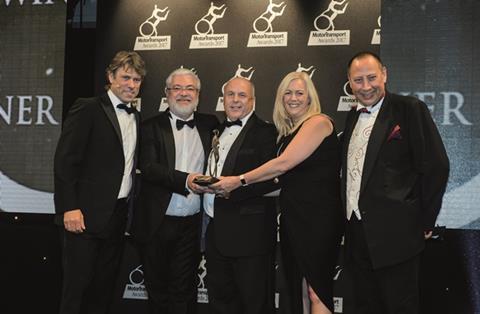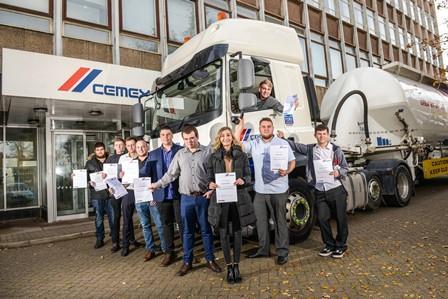
Cemex has developed an apprenticeship scheme to attract young people into the business, then trains them to be safe and competent drivers.
The driver shortage is reaching crisis levels, with the RHA estimating there will be a shortfall of up to 100,000 drivers across the industry by the end of next year.
One company taking a proactive approach to the problem is building materials producer and supplier Cemex UK, which runs a fleet of more than 300 articulated cement tankers and bulk aggregate tippers, employing 350 drivers, up to 80 agency drivers, and logistics support staff. Its approach saw it take the Apprenticeship of the Year award at this year’s MT Awards.
In 2014 Cemex UK created a scheme to provide a long-term solution to the problem of an ageing driver workforce, a lack of new drivers and dwindling agency resources. The scheme involves site-based learning, theory, practical and driving elements.
Business plan
A business case was developed and approved by the board for the pilot scheme, and nine apprentices were taken on. In 2015 the scheme was extended to the cement division and 15 apprentices were taken on.
Carl Milton, regional logistics manager at Cemex UK, said: “It’s key that any apprenticeship programme has buy-in from the top of the organisation. You cannot just implement a successful apprenticeship scheme without a well thought-out and approved business plan. It has to fit and work for the organisation and bring positive benefits for the company, its employees, the apprentices and the local communities in which we operate.
“We were given the full backing of the Cemex board from the initial pilot, and there is an annual update to the senior team on the progression of the scheme.”
The apprenticeships are advertised on the government Apprenticeship Vacancy Matching Service website, various recruitment sites and internally. After an initial screening of the applicants, there is a phone interview followed by a face to face interview, testing and practical driving assessment.
The 2017 drive attracted 331 applicants for 18 positions across 15 sites. These were filtered down to 87 candidates who were put though a rigorous interview and assessment process. This focused on safety, driving skills and ability – including practical driving assessment and testing – with candidates evaluated and tested for personal maturity, motivation and commitment.
Costs offset
Costs are offset by a combination of Apprenticeship Levy funding and the value the apprentices bring to the business as productive drivers.
“A points-based system ensures the process is rigorous and fair in evaluating who wins the placements,” said Milton. “This year we have also piloted additional process, via Thomas International, involving a personal profile analysis focusing on emotional intelligence and we hope this will further our ability to select and retain the best candidates.”
Apprentices are put on the payroll as full-time employees from day one and given a driving job on full pay when they have successfully completed the one-year programme. There are no retention clauses if they decide to move on from the scheme.
"This is a big draw for candidates, whereby we ensure successful candidates have Cemex’s full commitment and recognition of their hard work in successfully completing the scheme with the reward of a fully paid role at the end,” said Milton. "The commitment gives stability to the apprentice in that from day one they are part of a team and on a flight path to a career within the company.”

Cemex selected System Training as its partner to design a bespoke driver apprenticeship programme covering specialist training for tipper work in quarries and construction as well as pressurised tank work for cement tankers.
A joint support team ensures the apprenticeship scheme receives adequate resources with regular reviews and a progress report to prioritise any issues.
There are also regular update conference calls and one-to-one apprentice reviews involving the Cemex manager and the System Training adviser.
“It is key that to run a successful levy approved apprenticeship scheme you have a professional training resource and partner who is accredited and audited by the regulatory bodies,” said Milton. “This partnership includes the provision of jointly-produced training materials and a year’s training plan that exceeds the basic required framework and mandatory elements, encompassing specific company requirements and with a heavy focus on health and safety and vulnerable road users.
“It includes the training and booking of licensing tests, workbooks, evidence-based learning records, joint individual progress reports and reviews.”
Each apprentice receives a comprehensive course workbook that covers all aspects of the company, course content and key subject areas such as health and safety.
Bridging the gap
Candidates have a training adviser assigned from System Training – and independent of Cemex – for guidance, coaching and assessment through the specific training external modules.
They are also assigned a driver buddy, manager and lead driver mentor. The mentors are volunteers who coach the apprentices on a one-to-one basis and who are given external training and certification for mentoring skills.
Milton said: “The mentors are key to the process in bridging the practical knowledge and experience gap, and help to coach and guide young people into a professional driving career.
“This has proved to be very rewarding for the mentors who share experience and develop the apprentices and also accelerates the teamwork element and workforce engagement in the programme. Buddy drivers also have an important role in providing support for the mentor.”
The 12-month programme is flexible and each candidate can complete the various elements to meet individual timing and organisational timescales. There is also a comprehensive induction process, carried out at a local level, which covers site, safety and people inductions.
Progress
Once apprentices have gained the category C licence, they can progress to take the C + E, with a programme of on-road training and assessment to ensure they are fully competent before they take to the road themselves.
To assist with driver feedback, each apprentice’s truck is equipped with six cameras that film the driver in the cab, around the vehicle and record GPS location and time.
Managers organise visits to other facilities to give apprentices an appreciation of the wider industry, including the Rugby cement works and the Daf assembly line at Leyland and vehicle repair facilities.
“Visiting manufacturing sites and customer sites during supervised deliveries is key to opening up the apprentices to what the supply chain is all about,” said Milton. “We are a major supplier to the construction industry and it is great to understand that your contribution as an HGV driver is key to how a complex supply chain works from digging stone out of the ground to making construction materials that build our roads, houses, schools, offices, factories and infrastructure.
“This helps to create value and pride in a driver’s role in the
logistics industry.”
Two apprentices have already progressed from the 2014 scheme, with one moving to a quarry manager development role and the other into a more senior production operator role.
Cemex’s first female former apprentice is based at its Rugby Cement operation, hauling bulk cement in a 44-tonne truck.
She has been recognised with the Talent in Logistics Apprentice of the Year award for advancing the profile of women in logistics.
Milton said: “We developed a scheme that is balanced between our normal staff turnover and a viable company recruitment stream for developing young, skilled workers.
“The age profile of our driver workforce is improving, as is our available talent pool. We believe we have developed a sustainable apprenticeship scheme that should be self-sustaining year on year.”
THE WINNING FORMULA
Judges were looking for a well-structured apprenticeship scheme that met the business’s needs, had a good take-up, high retention rates and a good rate of employment at the end of the scheme. Cemex’s winning entry stood out because it focused on recruiting and training HGV drivers rather than vehicle technicians.
One of the judges said: “This is a bespoke programme designed for the company’s needs”, and “there is a good recruitment process which has attracted lots of applicants.”
Another judge said: “The backing of the board is essential, while mentors and coaches are also key to its success.”
Paula Sedgwick, HR manager, logistics at Cemex, said: “It’s recognition of the hard work of the logistics team – everybody’s involved in this from top to bottom.”
YOUNG TALENT
Cemex’s website hosts an “apprentice community” section with a series of blog articles for staff to read.
In 2013 the company had no logistics drivers under the age of 27 but in 2016, it had 18 drivers aged between 19 and 25.
Carl Milton said: “We think it’s important to develop young talent and we are delighted about winning the Apprenticeship of the Year
category at the MT Awards.”











